Computer Clustering Report: Server, Application, and System Analysis
VerifiedAdded on 2022/10/09
|6
|1340
|20
Report
AI Summary
This report provides an in-depth analysis of computer clustering, a crucial technology in today's rapidly evolving technological landscape. It begins by defining computer clustering and its role in enhancing competitive advantage in the business world. The report then delves into server clustering, detailing its architecture, including failover systems, and discusses its advantages, such as scalability and efficient maintenance, and its disadvantages, primarily cost implications. Furthermore, the report explores application clustering, highlighting its benefits in providing fault-tolerant systems and efficient data management. The report concludes by emphasizing the importance of adaptability in response to changing technology trends and reinforces the advantages of server clustering in increasing reliability and high availability. It also includes references to support the analysis and findings.
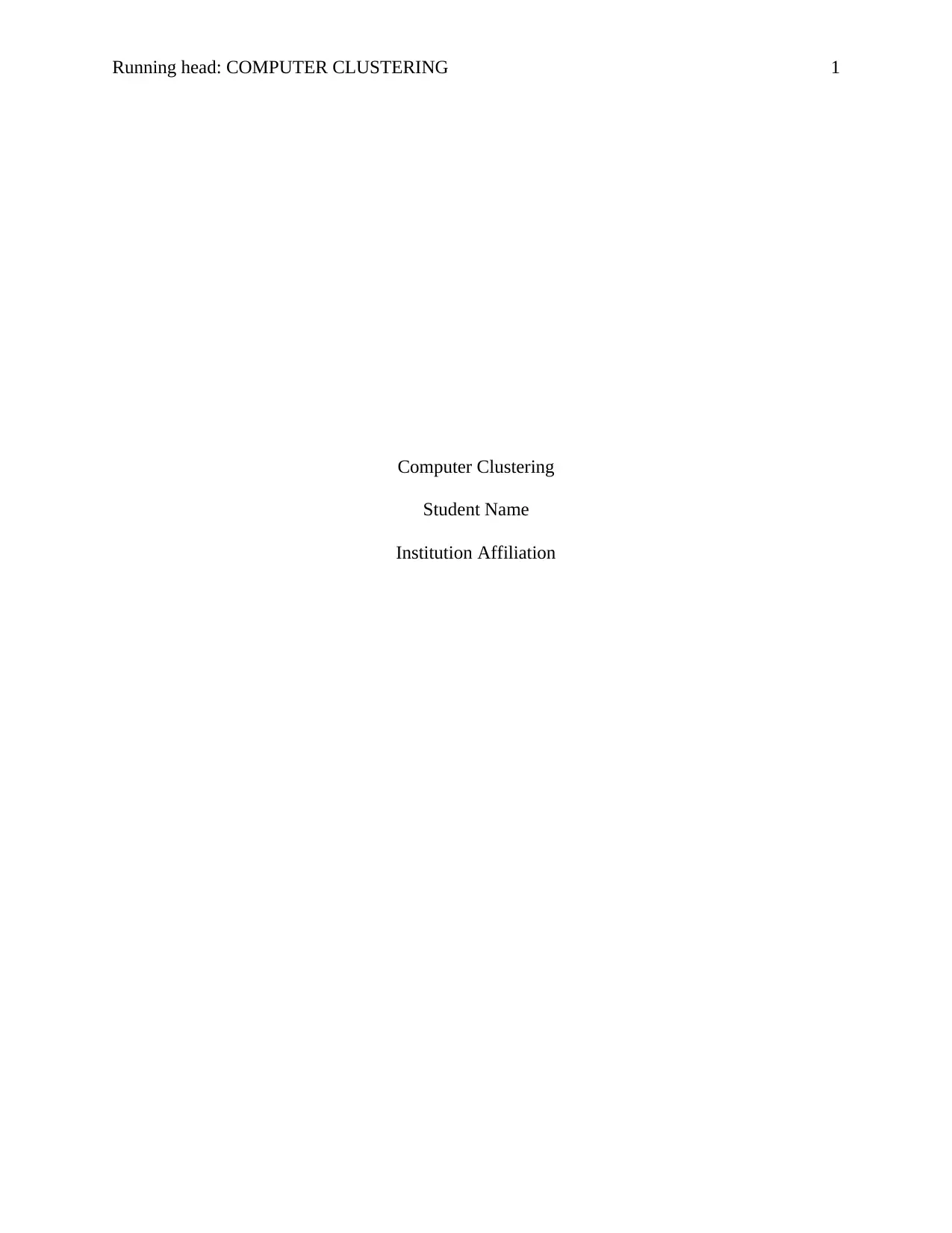
Running head: COMPUTER CLUSTERING 1
Computer Clustering
Student Name
Institution Affiliation
Computer Clustering
Student Name
Institution Affiliation
Paraphrase This Document
Need a fresh take? Get an instant paraphrase of this document with our AI Paraphraser
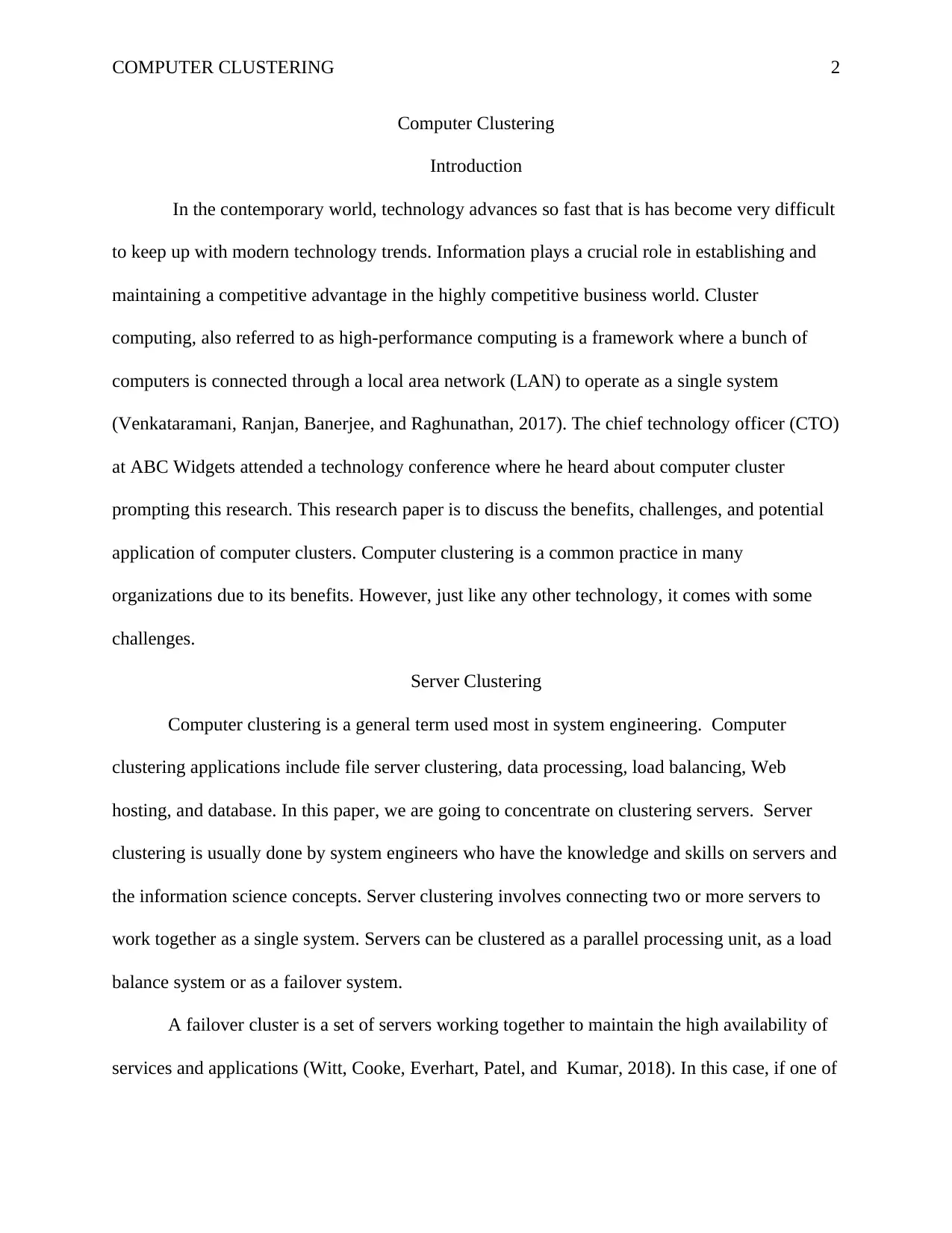
COMPUTER CLUSTERING 2
Computer Clustering
Introduction
In the contemporary world, technology advances so fast that is has become very difficult
to keep up with modern technology trends. Information plays a crucial role in establishing and
maintaining a competitive advantage in the highly competitive business world. Cluster
computing, also referred to as high-performance computing is a framework where a bunch of
computers is connected through a local area network (LAN) to operate as a single system
(Venkataramani, Ranjan, Banerjee, and Raghunathan, 2017). The chief technology officer (CTO)
at ABC Widgets attended a technology conference where he heard about computer cluster
prompting this research. This research paper is to discuss the benefits, challenges, and potential
application of computer clusters. Computer clustering is a common practice in many
organizations due to its benefits. However, just like any other technology, it comes with some
challenges.
Server Clustering
Computer clustering is a general term used most in system engineering. Computer
clustering applications include file server clustering, data processing, load balancing, Web
hosting, and database. In this paper, we are going to concentrate on clustering servers. Server
clustering is usually done by system engineers who have the knowledge and skills on servers and
the information science concepts. Server clustering involves connecting two or more servers to
work together as a single system. Servers can be clustered as a parallel processing unit, as a load
balance system or as a failover system.
A failover cluster is a set of servers working together to maintain the high availability of
services and applications (Witt, Cooke, Everhart, Patel, and Kumar, 2018). In this case, if one of
Computer Clustering
Introduction
In the contemporary world, technology advances so fast that is has become very difficult
to keep up with modern technology trends. Information plays a crucial role in establishing and
maintaining a competitive advantage in the highly competitive business world. Cluster
computing, also referred to as high-performance computing is a framework where a bunch of
computers is connected through a local area network (LAN) to operate as a single system
(Venkataramani, Ranjan, Banerjee, and Raghunathan, 2017). The chief technology officer (CTO)
at ABC Widgets attended a technology conference where he heard about computer cluster
prompting this research. This research paper is to discuss the benefits, challenges, and potential
application of computer clusters. Computer clustering is a common practice in many
organizations due to its benefits. However, just like any other technology, it comes with some
challenges.
Server Clustering
Computer clustering is a general term used most in system engineering. Computer
clustering applications include file server clustering, data processing, load balancing, Web
hosting, and database. In this paper, we are going to concentrate on clustering servers. Server
clustering is usually done by system engineers who have the knowledge and skills on servers and
the information science concepts. Server clustering involves connecting two or more servers to
work together as a single system. Servers can be clustered as a parallel processing unit, as a load
balance system or as a failover system.
A failover cluster is a set of servers working together to maintain the high availability of
services and applications (Witt, Cooke, Everhart, Patel, and Kumar, 2018). In this case, if one of
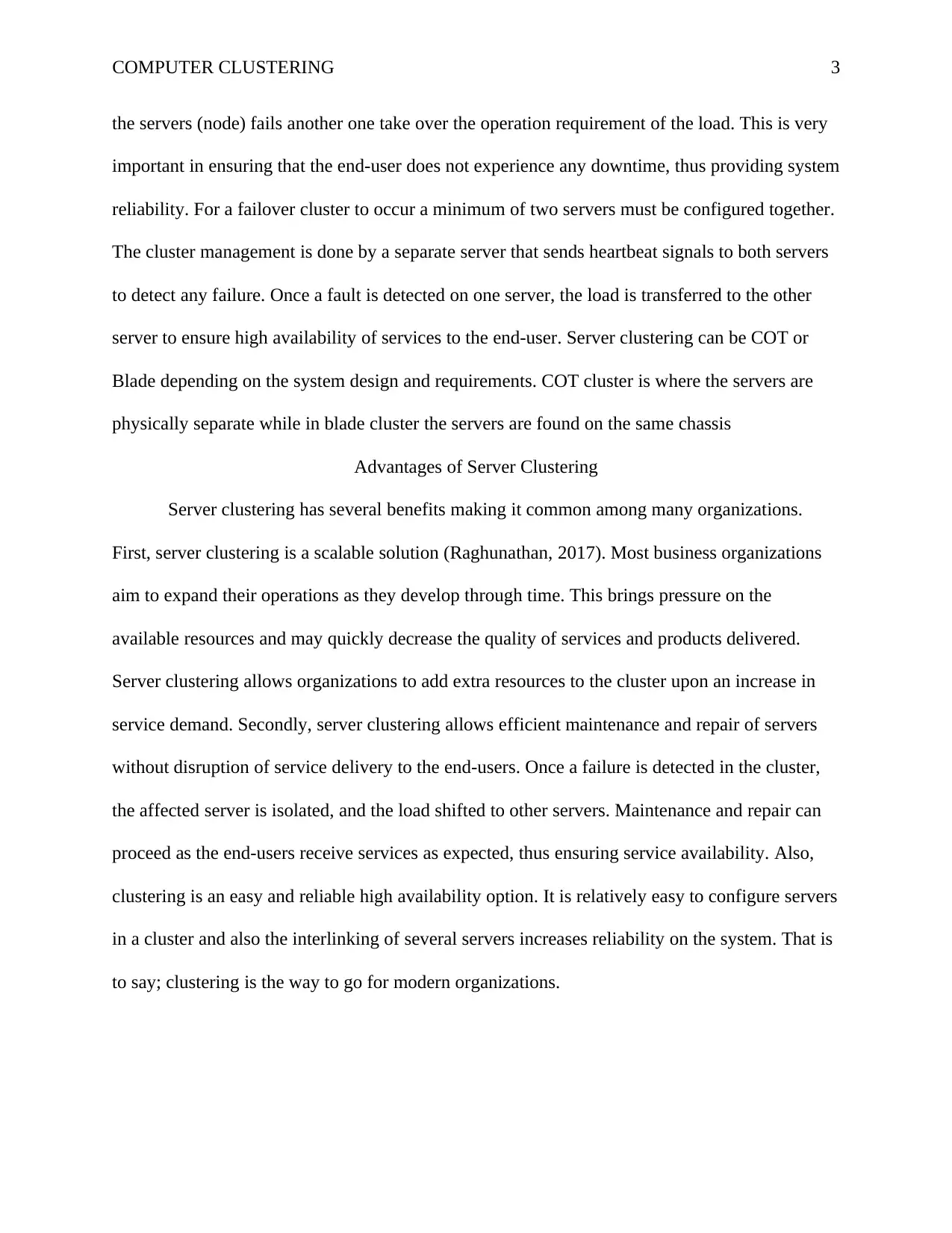
COMPUTER CLUSTERING 3
the servers (node) fails another one take over the operation requirement of the load. This is very
important in ensuring that the end-user does not experience any downtime, thus providing system
reliability. For a failover cluster to occur a minimum of two servers must be configured together.
The cluster management is done by a separate server that sends heartbeat signals to both servers
to detect any failure. Once a fault is detected on one server, the load is transferred to the other
server to ensure high availability of services to the end-user. Server clustering can be COT or
Blade depending on the system design and requirements. COT cluster is where the servers are
physically separate while in blade cluster the servers are found on the same chassis
Advantages of Server Clustering
Server clustering has several benefits making it common among many organizations.
First, server clustering is a scalable solution (Raghunathan, 2017). Most business organizations
aim to expand their operations as they develop through time. This brings pressure on the
available resources and may quickly decrease the quality of services and products delivered.
Server clustering allows organizations to add extra resources to the cluster upon an increase in
service demand. Secondly, server clustering allows efficient maintenance and repair of servers
without disruption of service delivery to the end-users. Once a failure is detected in the cluster,
the affected server is isolated, and the load shifted to other servers. Maintenance and repair can
proceed as the end-users receive services as expected, thus ensuring service availability. Also,
clustering is an easy and reliable high availability option. It is relatively easy to configure servers
in a cluster and also the interlinking of several servers increases reliability on the system. That is
to say; clustering is the way to go for modern organizations.
the servers (node) fails another one take over the operation requirement of the load. This is very
important in ensuring that the end-user does not experience any downtime, thus providing system
reliability. For a failover cluster to occur a minimum of two servers must be configured together.
The cluster management is done by a separate server that sends heartbeat signals to both servers
to detect any failure. Once a fault is detected on one server, the load is transferred to the other
server to ensure high availability of services to the end-user. Server clustering can be COT or
Blade depending on the system design and requirements. COT cluster is where the servers are
physically separate while in blade cluster the servers are found on the same chassis
Advantages of Server Clustering
Server clustering has several benefits making it common among many organizations.
First, server clustering is a scalable solution (Raghunathan, 2017). Most business organizations
aim to expand their operations as they develop through time. This brings pressure on the
available resources and may quickly decrease the quality of services and products delivered.
Server clustering allows organizations to add extra resources to the cluster upon an increase in
service demand. Secondly, server clustering allows efficient maintenance and repair of servers
without disruption of service delivery to the end-users. Once a failure is detected in the cluster,
the affected server is isolated, and the load shifted to other servers. Maintenance and repair can
proceed as the end-users receive services as expected, thus ensuring service availability. Also,
clustering is an easy and reliable high availability option. It is relatively easy to configure servers
in a cluster and also the interlinking of several servers increases reliability on the system. That is
to say; clustering is the way to go for modern organizations.
⊘ This is a preview!⊘
Do you want full access?
Subscribe today to unlock all pages.

Trusted by 1+ million students worldwide
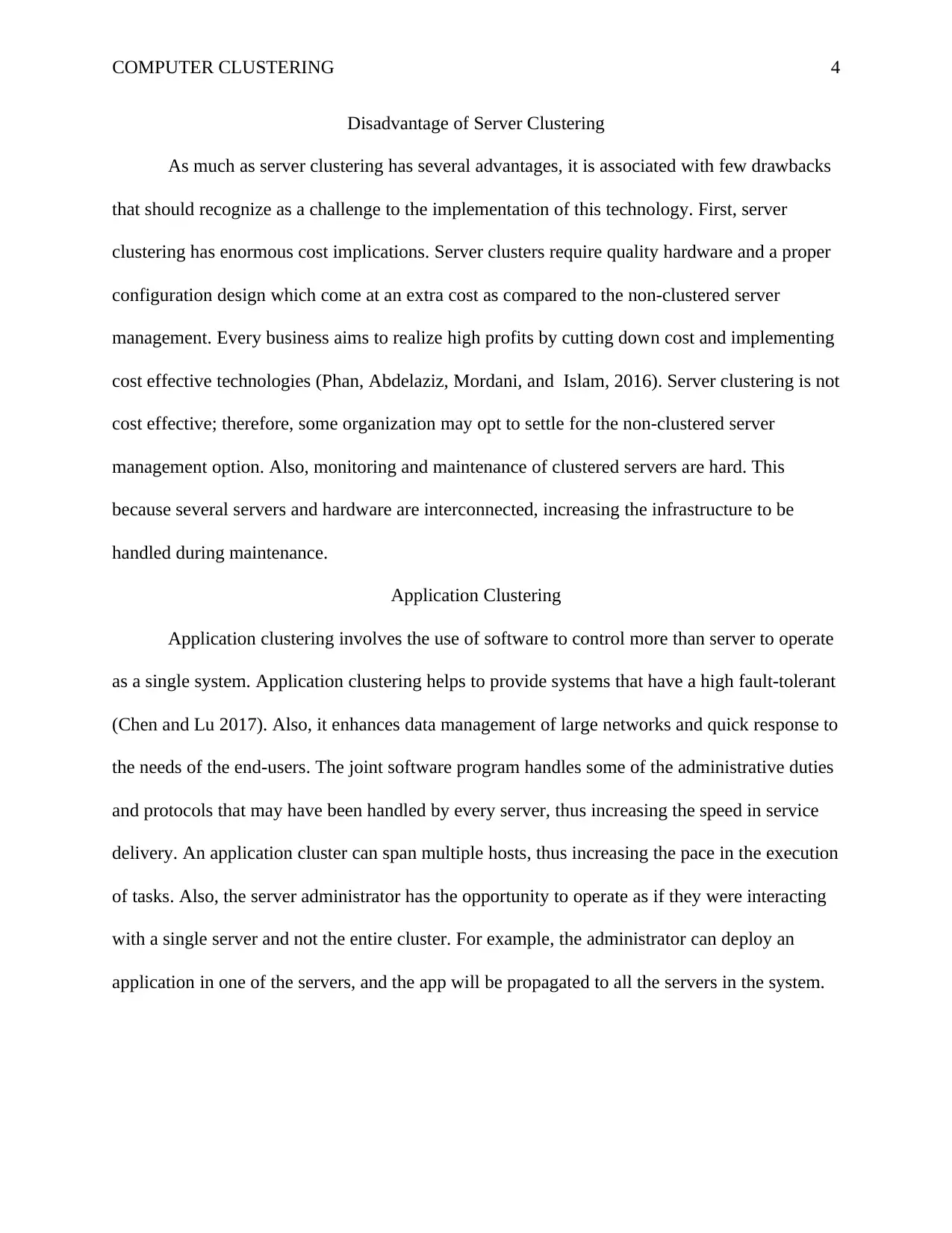
COMPUTER CLUSTERING 4
Disadvantage of Server Clustering
As much as server clustering has several advantages, it is associated with few drawbacks
that should recognize as a challenge to the implementation of this technology. First, server
clustering has enormous cost implications. Server clusters require quality hardware and a proper
configuration design which come at an extra cost as compared to the non-clustered server
management. Every business aims to realize high profits by cutting down cost and implementing
cost effective technologies (Phan, Abdelaziz, Mordani, and Islam, 2016). Server clustering is not
cost effective; therefore, some organization may opt to settle for the non-clustered server
management option. Also, monitoring and maintenance of clustered servers are hard. This
because several servers and hardware are interconnected, increasing the infrastructure to be
handled during maintenance.
Application Clustering
Application clustering involves the use of software to control more than server to operate
as a single system. Application clustering helps to provide systems that have a high fault-tolerant
(Chen and Lu 2017). Also, it enhances data management of large networks and quick response to
the needs of the end-users. The joint software program handles some of the administrative duties
and protocols that may have been handled by every server, thus increasing the speed in service
delivery. An application cluster can span multiple hosts, thus increasing the pace in the execution
of tasks. Also, the server administrator has the opportunity to operate as if they were interacting
with a single server and not the entire cluster. For example, the administrator can deploy an
application in one of the servers, and the app will be propagated to all the servers in the system.
Disadvantage of Server Clustering
As much as server clustering has several advantages, it is associated with few drawbacks
that should recognize as a challenge to the implementation of this technology. First, server
clustering has enormous cost implications. Server clusters require quality hardware and a proper
configuration design which come at an extra cost as compared to the non-clustered server
management. Every business aims to realize high profits by cutting down cost and implementing
cost effective technologies (Phan, Abdelaziz, Mordani, and Islam, 2016). Server clustering is not
cost effective; therefore, some organization may opt to settle for the non-clustered server
management option. Also, monitoring and maintenance of clustered servers are hard. This
because several servers and hardware are interconnected, increasing the infrastructure to be
handled during maintenance.
Application Clustering
Application clustering involves the use of software to control more than server to operate
as a single system. Application clustering helps to provide systems that have a high fault-tolerant
(Chen and Lu 2017). Also, it enhances data management of large networks and quick response to
the needs of the end-users. The joint software program handles some of the administrative duties
and protocols that may have been handled by every server, thus increasing the speed in service
delivery. An application cluster can span multiple hosts, thus increasing the pace in the execution
of tasks. Also, the server administrator has the opportunity to operate as if they were interacting
with a single server and not the entire cluster. For example, the administrator can deploy an
application in one of the servers, and the app will be propagated to all the servers in the system.
Paraphrase This Document
Need a fresh take? Get an instant paraphrase of this document with our AI Paraphraser
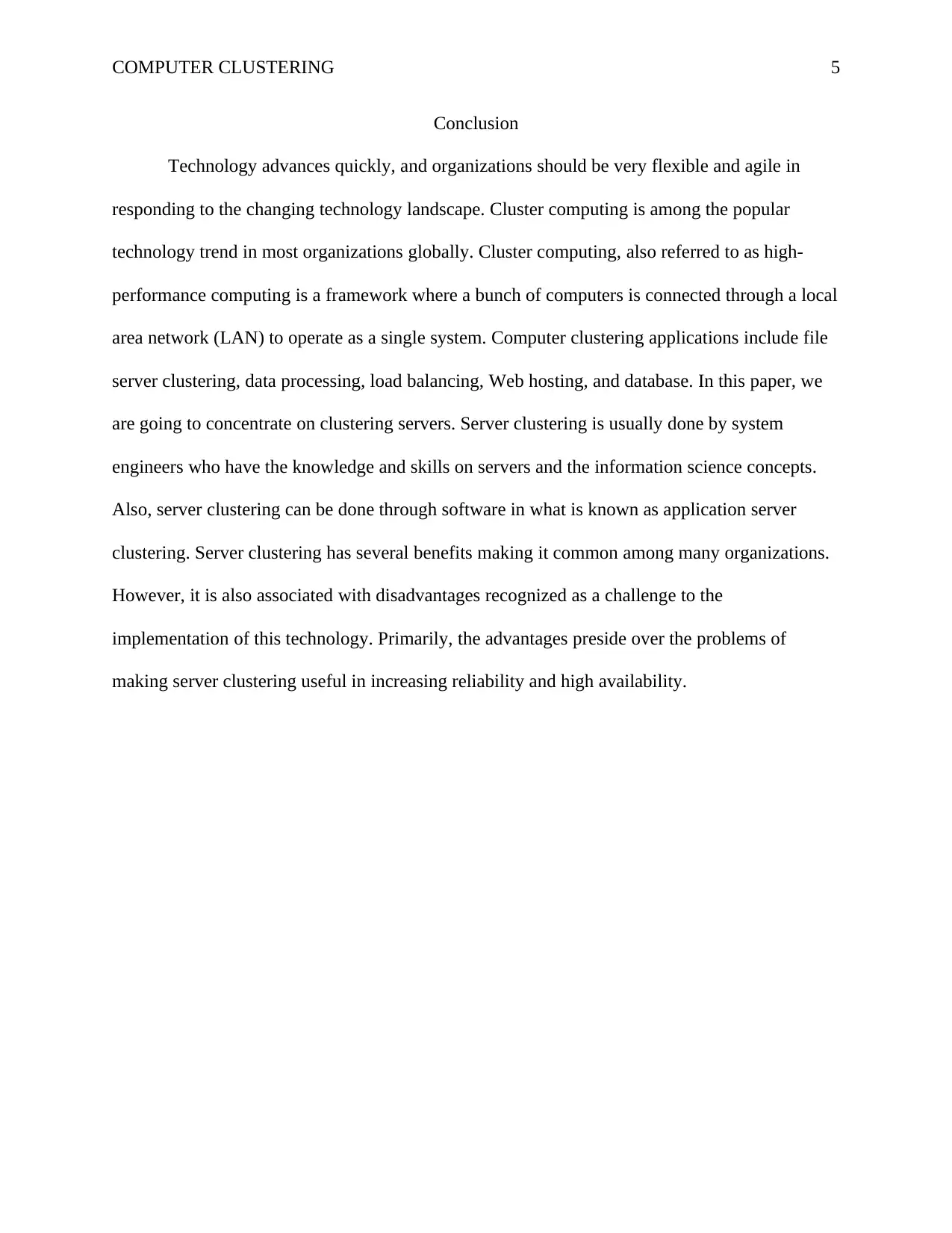
COMPUTER CLUSTERING 5
Conclusion
Technology advances quickly, and organizations should be very flexible and agile in
responding to the changing technology landscape. Cluster computing is among the popular
technology trend in most organizations globally. Cluster computing, also referred to as high-
performance computing is a framework where a bunch of computers is connected through a local
area network (LAN) to operate as a single system. Computer clustering applications include file
server clustering, data processing, load balancing, Web hosting, and database. In this paper, we
are going to concentrate on clustering servers. Server clustering is usually done by system
engineers who have the knowledge and skills on servers and the information science concepts.
Also, server clustering can be done through software in what is known as application server
clustering. Server clustering has several benefits making it common among many organizations.
However, it is also associated with disadvantages recognized as a challenge to the
implementation of this technology. Primarily, the advantages preside over the problems of
making server clustering useful in increasing reliability and high availability.
Conclusion
Technology advances quickly, and organizations should be very flexible and agile in
responding to the changing technology landscape. Cluster computing is among the popular
technology trend in most organizations globally. Cluster computing, also referred to as high-
performance computing is a framework where a bunch of computers is connected through a local
area network (LAN) to operate as a single system. Computer clustering applications include file
server clustering, data processing, load balancing, Web hosting, and database. In this paper, we
are going to concentrate on clustering servers. Server clustering is usually done by system
engineers who have the knowledge and skills on servers and the information science concepts.
Also, server clustering can be done through software in what is known as application server
clustering. Server clustering has several benefits making it common among many organizations.
However, it is also associated with disadvantages recognized as a challenge to the
implementation of this technology. Primarily, the advantages preside over the problems of
making server clustering useful in increasing reliability and high availability.
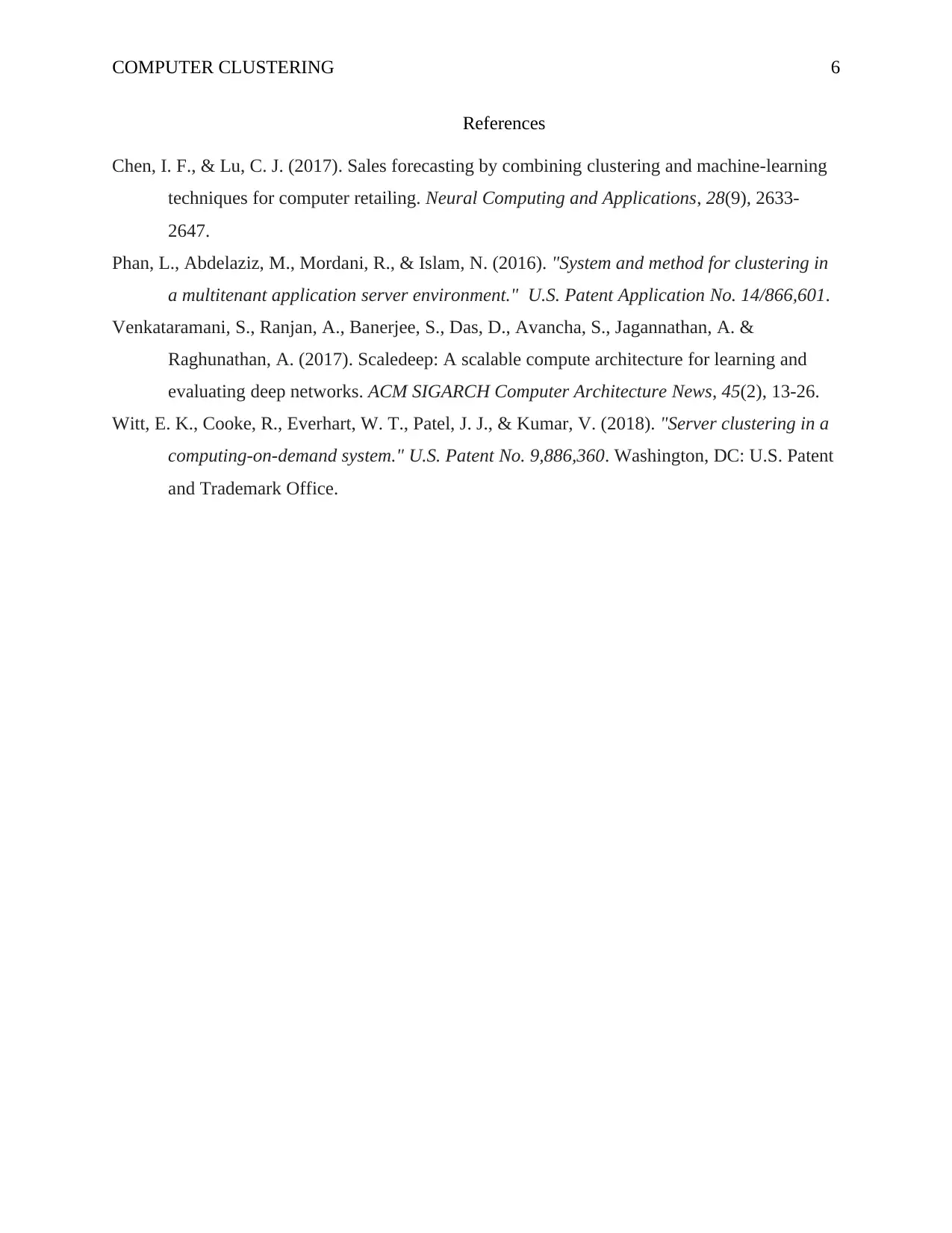
COMPUTER CLUSTERING 6
References
Chen, I. F., & Lu, C. J. (2017). Sales forecasting by combining clustering and machine-learning
techniques for computer retailing. Neural Computing and Applications, 28(9), 2633-
2647.
Phan, L., Abdelaziz, M., Mordani, R., & Islam, N. (2016). "System and method for clustering in
a multitenant application server environment." U.S. Patent Application No. 14/866,601.
Venkataramani, S., Ranjan, A., Banerjee, S., Das, D., Avancha, S., Jagannathan, A. &
Raghunathan, A. (2017). Scaledeep: A scalable compute architecture for learning and
evaluating deep networks. ACM SIGARCH Computer Architecture News, 45(2), 13-26.
Witt, E. K., Cooke, R., Everhart, W. T., Patel, J. J., & Kumar, V. (2018). "Server clustering in a
computing-on-demand system." U.S. Patent No. 9,886,360. Washington, DC: U.S. Patent
and Trademark Office.
References
Chen, I. F., & Lu, C. J. (2017). Sales forecasting by combining clustering and machine-learning
techniques for computer retailing. Neural Computing and Applications, 28(9), 2633-
2647.
Phan, L., Abdelaziz, M., Mordani, R., & Islam, N. (2016). "System and method for clustering in
a multitenant application server environment." U.S. Patent Application No. 14/866,601.
Venkataramani, S., Ranjan, A., Banerjee, S., Das, D., Avancha, S., Jagannathan, A. &
Raghunathan, A. (2017). Scaledeep: A scalable compute architecture for learning and
evaluating deep networks. ACM SIGARCH Computer Architecture News, 45(2), 13-26.
Witt, E. K., Cooke, R., Everhart, W. T., Patel, J. J., & Kumar, V. (2018). "Server clustering in a
computing-on-demand system." U.S. Patent No. 9,886,360. Washington, DC: U.S. Patent
and Trademark Office.
⊘ This is a preview!⊘
Do you want full access?
Subscribe today to unlock all pages.

Trusted by 1+ million students worldwide
1 out of 6
Related Documents
Your All-in-One AI-Powered Toolkit for Academic Success.
+13062052269
info@desklib.com
Available 24*7 on WhatsApp / Email
![[object Object]](/_next/static/media/star-bottom.7253800d.svg)
Unlock your academic potential
Copyright © 2020–2025 A2Z Services. All Rights Reserved. Developed and managed by ZUCOL.





